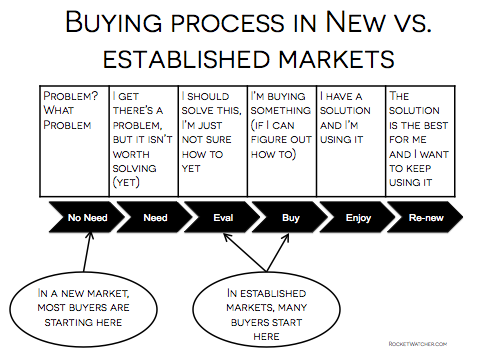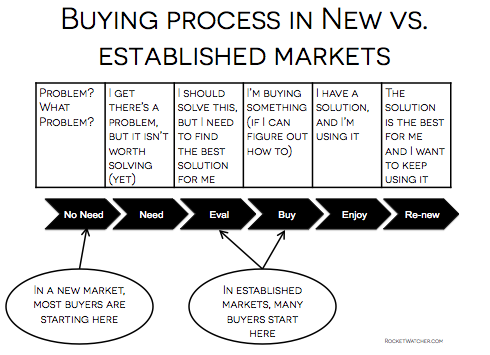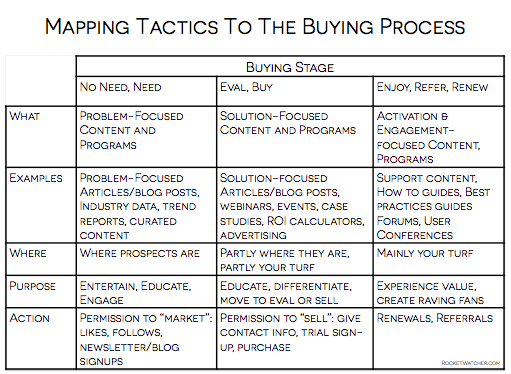Established markets and new markets are not the same so the way that you market and sell to them is different. For startups, it’s really important to know the difference. For each type of market are using different marketing tactics, executed in different ways with different expected results.
New versus Established Markets – The Problem Gap
In an established market, there are prospects out there that understand that they have a problem that needs to be solved. There will also be prospects actively in the process of learning about, shopping for and purchasing solutions.
In new markets, prospects are blissfully unaware that they even have a problem. They aren’t researching solutions or shopping for solutions to a problem that they don’t know they have.
If we think about a typical buyer journey we can see that in new markets, the bulk of buyers are starting at a different starting point than the buyers in a more established markets.
Creating Demand VS. Capturing Demand
So how are the marketing tactics different for these different markets? For new markets the first job of marketing is to educate your target segment that there is a problem to be solved in the first place. This is counterintuitive for many startup who would rather jump in and talk about why their solution is better than other solutions. Until prospects believe they have a problem to solve, efforts to market solutions will be really ineffective. Why should I care about your solution? I don’t even have that problem!
When there is no demand for your solution, tactics that we typically use to capture existing demand are ineffective. People aren’t searching for solutions so using advertising or SEO to drive people to sign up will have limited success – there simply aren’t enough people ready to buy.
Marketers in new markets have to start by educating the market that there is problem. Many of the tactics you might use here look like tactics you would use later in the buying process but the content used to support them and the “Ask” are different.
For example, let’s say you have a marketing solution for Snapchat. You might decide to create a blog and write a series of blog posts to try to engage with a community of marketers that are likely to use Snapchat as a marketing channel. After talking to marketers however, you learn that most of them aren’t using Snapchat today, nor do they see that as a viable place to do marketing. Your marketing might include blog posts, ebooks, infographics, video, etc. and the content in there will be around demonstrating that marketers are missing the boat on this new platform. You could do this with case studies of how other folks have used it, data that demonstrates the potential of the platform as a channel, examples of content that is already being shared there, etc. You might want to run a snapchat campaign yourself (not to capture marketers who have already demonstrated their cluelessness about the platform) but to gather your own data about how a campaign might potentially work.
If we take the same example but go with the insight that the target segment is already interested in using Snapchat as a marketing channel and might be actively looking for ways to make that easier, you can imagine that some of the tactics would be the same (blog posts, infographics, video) but the content in them would be different. In this case you wouldn’t have to convince your audience that Snapchat is cool, you would have to convince them that your solution is better than whatever they are using today. The content of your marketing content is different because the context is different. In this case there would also be other tactics you could add – paid advertising, email marketing, events, webinars, creating a buyers guide, outbound telemarketing – that are designed to capture folks that are further down the buying process and are already shopping for a solution.
The Ask: Entertainment VS Education VS Selling
If I am marketing into an existing market and there are folks that are already searching for solutions then it makes sense that I can just get out there and sell to those prospects. On the other hand, if my prospects don’t realize they have a problem worth solving yet, I first have to help them understand the cost of not solving the problem before I can try to convince them that my solution is the best out there and they should buy it. The “Ask” (what I am asking my prospects to do) when they click on my link or hit my landing page can’t be “Sign up for a trial” or “Buy now” for folks in these earlier stages. In new markets, frequently the “Ask” is “please allow me to keep talking to you”. That might mean subscribing to a blog or a newsletter or following my updates on social media. Once I have your permission to do that, then later when you are ready to buy, I can ask for permission sell you something.
The other thing to keep in mind is that prospects that don’t know they need your stuff yet aren’t really all that interested in investing the time to learn anything quite yet. If your content can be funny or inspiring or just generally interesting, you have a better chance of getting permission to keep talking to them.
Here’s a chart I have used in workshops to illustrate the differences between tactics that are used at different stages.
This post was inspired by a post from Boris Wertz over at Version One called How to spark demand when creating a new market space.



